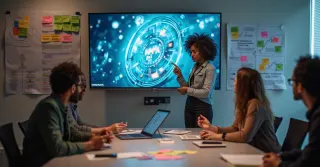Motion Graphics In Marketing

Motion graphics in digital marketing have emerged as a critical resource for brands looking to enhance their online presence and connect with their viewers more effectively. As viewing habits shorten, motion graphics shine by grabbing the viewer’s interest in seconds. By incorporating animated elements and motion graphics, companies are able to convey core concepts in an accessible and appealing way, creating a deeper relationship with their customers. Content creation specialists have understood that motion graphics can elevate audience engagement but also generate more interactions across multiple platforms. The impact of motion and animations working together allows businesses to create engaging messages that resonate with audiences in a fast-paced online environment.
For businesses aiming to communicate ideas quickly and memorably, motion graphics deliver the right mix of brevity and appeal. Unlike still visuals or basic written content, motion graphics utilize movement and striking design to convey sentiments and highlight key messages. This unique mix of visuals and messaging speaks to both the rational and emotional sides of viewers, making it more effective to influence purchase decisions and foster customer trust. Digital marketers often employ motion graphics in promotional efforts, branding initiatives, and educational content to ensure their messages leave a lasting impression.
One of the key reasons motion graphics are so impactful is their versatility. They can be customized to suit various digital marketing strategies, including paid promotions, email campaigns, site updates, and digital ads. Whether implemented as animated infographics, graphic narratives, or product demonstrations, motion graphics add a dynamic dimension to content that traditional graphics simply cannot match. This adaptability ensures that businesses remain relevant and noteworthy in a busy digital landscape, connecting with audiences across diverse channels.
Motion graphics also serve as a key component in breaking down complex information. In fields such as accounting, wellness, and engineering, where technical jargon and facts can discourage audiences, animated visuals unpack dense subjects into approachable and visually appealing stories. This makes it simpler for brands to share knowledge and establish themselves as trusted sources of information. Digital artists who specialize in motion graphics expertly balance visual appeal with clarity, making sure that the end result is both valuable and visually engaging.
The emotive power of motion graphics is profound. By combining narrative techniques, color dynamics, and audio engineering, motion graphics offer captivating experiences that evoke real emotional connections from viewers. These connections are crucial for establishing brand presence, as they foster ties rooted in credibility and sincerity. Skilled creators who specialize in motion graphics are skilled at crafting narratives that stay true to the brand's ethos, developing a unique brand tone that speaks to the intended audience.
Another strength of dynamic visuals is their ability to increase shareability. On popular platforms such as Instagram, TikTok, and Facebook, where video content is king, motion graphics are inherently shareable, amplifying organic visibility. This organic amplification is essential for brands seeking greater brand awareness while minimizing ad spend. Content marketing experts recognize that the shareability of motion graphics not only increases brand visibility but also builds a stronger community and loyalty among fans.
The production quality of motion graphics also enhance their impact. Professional-grade animations demand the expertise of animators, designers, and audio specialists to bring ideas to life. From seamless transitions to precise frame rates to typography and color grading, every detail is meticulously crafted to maintain brand consistency. Visual content creators are always exploring new tools and techniques, pushing creative boundaries in the fast-paced digital space.
When combined with comprehensive marketing efforts, dynamic visuals amplify the impact of campaigns by reinforcing brand visuals across touchpoints. This visual alignment solidifies brand image and establishes brand awareness. Organizations that invest in motion graphics as part of their content marketing plans commonly report better results, as these visuals support marketing initiatives.
Animated visuals are not just about style—they’re a strategic tool for driving conversions. Studies have shown that video content, particularly motion graphics, can significantly improve conversion rates by clarifying product value, offering real-world use examples, and guiding viewers through the buyer’s journey. By integrating motion graphics into product pages and landing pages, brands can minimize bounce rates and encourage visitors to take the next step, whether that’s submitting a form.
The prospects for motion graphics in marketing is exciting, with new technologies and trends constantly reshaping digital communication. Innovations like augmented reality, interactive videos, and 3D animation are pushing the boundaries of visual storytelling, making them richer and more compelling. Creative digital artists are actively embracing cutting-edge tools to maintain a competitive edge and offer state-of-the-art solutions for their brands.
In the crowded digital landscape, animated visuals have proven to be a powerful tool for grabbing interest, making complex ideas more accessible, and strengthening emotional ties. By prioritizing exceptional visual content, companies can enhance their narrative, differentiate themselves from competitors, and ultimately drive meaningful results in their content strategies. The art of visual content creation continues to evolve, and dynamic videos stand as a leading force of this constantly evolving space, unleashing endless creative possibilities.










